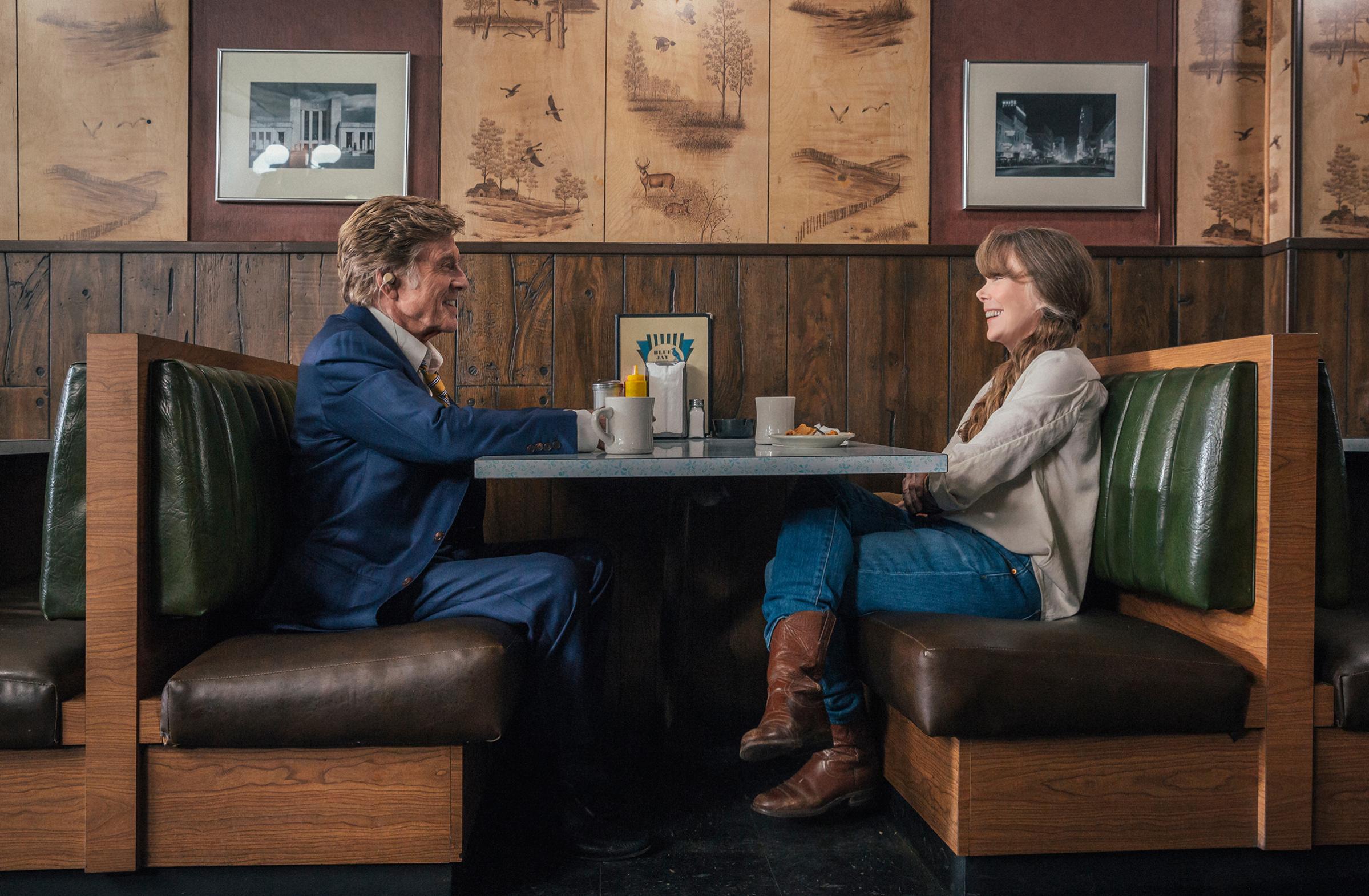The Old Man & the Gun stars Robert Redford as a charismatic bank robber and prison escape artist named Forrest Tucker. His real-life exploits were originally documented in a 2003 New Yorker article of the same name, written by David Grann.
Set in 1981, Tucker and his two elderly associates, dubbed the “Over the Hill Gang,” embark on a series of bank heists across the Southwest. On their trail is beleaguered detective John Hunt, played by Casey Affleck, who uncovers Tucker’s storied criminal past. In the midst of the spree, Tucker develops a relationship with a horse-riding widow named Jewel (Sissy Spacek) who is unaware of his true identity.
The Old Man & the Gun calls itself a “mostly true story,” and it’s a fitting description. The film stays mostly loyal to its source material, relying on details from Grann’s reporting. After all, Forrest Tucker’s life was practically tailor-made for cinematic adaptation. However, the film still takes some artistic liberties with the story, particularly in Tucker’s romance with Jewel, the timeline of events and the ending, which is rose-tinted version of what really happened.
Here is what’s fact and fiction in The Old Man & the Gun.
Fact: Tucker’s robbery methods are portrayed accurately
Just about every detail regarding Tucker’s technique were taken directly from his interview with Grann. Tucker would cover his fingertips with superglue to disguise his fingerprints, and approach the tellers with a calm, collected demeanor. His dubbed his earpiece, which was tuned to a police scanner, the “Forrest Tucker trademark.” The scene where Tucker explains his methods to Jewel features a monologue based on the real Tucker’s description of his methods, as transcribed by Grann.

Fact: Tucker’s confidants are also based on real people
Teddy Green, played by Danny Glover, is modeled after Theodore Green, a notorious bank robber who Tucker met during a stint at Alcatraz. As portrayed in the movie, Green worked with Tucker to commit the real Over the Hill Gang robberies, and was the person who eventually landed Tucker in prison.
The third man is more of a composite character. Tom Waits’ Waller likely gets his name from John Waller, one of the men who escaped from San Quentin with Tucker in 1979. But according to the LA Times, the real Waller was arrested just months after their escape, so he did not take part in the robberies. Tucker and Green did work with other men throughout this particular spree, but their identities remain a mystery. In one of their conversations, Tucker told Grann that some men he worked with are still out there, and he refused to reveal their identities.
Fact and Fiction: Jewel was actually Jewell Centers, a wealthy Florida heiress, and she and Tucker were married.
Many of the sweeter moments in the movie come from the courtship between Tucker and Jewel. Spacek’s character is portrayed as a cash-strapped horse rancher living on a quiet farm outside Dallas. Jewel alludes to her financial situation at several points in the film, which prompts Tucker to try and secretly pay off her mortgage.

The Jewel in the movie bears little resemblance to the actual woman she is based on. Jewell Centers was a shipping heiress who lived in Miami, and was Tucker’s third wife. After he escaped from San Quentin in 1979, Tucker and Centers met at a private beach club in Florida, and were wed in 1982, according to the LA Times.
The real Tucker used the pseudonym Bob Callahan with her, and claimed to be a successful stock broker. While the film gives a sense that Jewel was somewhat suspect of Tucker’s life of crime, there was no evidence of that in Grann’s account or any other source. Centers was entirely unaware of his true identity until his eventual arrest in 1983. Yet, despite this discovery, Centers remained devoted to him, and was quoted saying “I love him. I’ll always love him.”
Fiction: It took police a few years to catch Tucker following his Over the Hill Gang spree
For the sake of the film, the timeline for the crimes he and his various accomplices committed as the Over the Hill Gang were condensed. While the gang managed to rob around 60 banks in Oklahoma and Texas in 1980, it took police 3 years to finally catch Tucker. The heist where Tucker and the gang posed as bank security took place in Boston in 1983, not in St. Louis. After settling down with Centers, Tucker continued to rob grocery stores and banks in Florida and Boston until his arrest.
Fact: Tucker and his associates successfully posed as bank security
The most impressive heist in the film involved Tucker, Green and Waller posing as bank security guards and stealing a significant amount of gold from the vault. According to Grann, the men donned costumes and fake moustaches and proceeded to steal $430,000 after locking two tellers and the manager in the vault. It was also this particular heist that allowed police to identify Tucker as the leader of the Over the Hill Gang, and led to his arrest in 1983.
Fact: Tucker really did escape from San Quentin in a handmade rowboat
When Hunt travels to San Francisco to learn about Tucker’s past, he discovers that Tucker has escaped from prison a staggering 18 times. What seems like an easy thing to exaggerate for the sake of the film turns out to be true: Tucker was truly a masterful escape artist. His escape from San Quentin in 1979 was prominently featured in the film, and every little detail is accurate: The boat has a fake Marin Yacht Club flag and the words “rub a dub dub” painted on the side. An additional detail: Tucker told Grann that as they were escaping their boat capsized, and a guard convinced by their disguise offered to help them get to shore.
The scene where Tucker hands a list of his escapes to Jewel really happened—but not with her
After Tucker is arrested in the film Jewel comes to visit him. Tucker comes clean about his identity and slips Jewel a list of his 18 prison escapes, including a number 19, which he intentionally left blank. Jewel convinces Tucker to stay put and serve out his sentence. Making this list may seem theatrical, but it was mostly true to life—only the timeline and recipient were different.
After Tucker’s arrest in 1983, Tucker initially tried to escape, but Centers said she would stay with him if he “vowed to rehabilitate himself.” So Tucker instead spent his time documenting his life exploits in the hopes of one day being the subject of a Hollywood movie. He was released in 1993. Centers purchased a home on a golf course in Florida where they lived together, and Tucker spent several years without committing a crime. That is, until his final spree in 1999. Tucker went back to prison, spending the rest of his life behind bars.
In order to write the New Yorker profile, Grann visited Tucker in prison several times. It was during one of Grann’s final visits with Tucker when he received that very list, including the blank number 19. At this point, Grann noted that Tucker, now in his 80s, was “alarmingly frail” and relied on a wheelchair. Tucker never managed a 19th escape, dying in 2004. He expressed regret for landing himself in prison, saying “What hurts most . . . is that I know how much I disappointed my wife…That hurts more than anything.”
More Must-Reads from TIME
- Why Trump’s Message Worked on Latino Men
- What Trump’s Win Could Mean for Housing
- The 100 Must-Read Books of 2024
- Sleep Doctors Share the 1 Tip That’s Changed Their Lives
- Column: Let’s Bring Back Romance
- What It’s Like to Have Long COVID As a Kid
- FX’s Say Nothing Is the Must-Watch Political Thriller of 2024
- Merle Bombardieri Is Helping People Make the Baby Decision
Write to Wilder Davies at wilder.davies@time.com